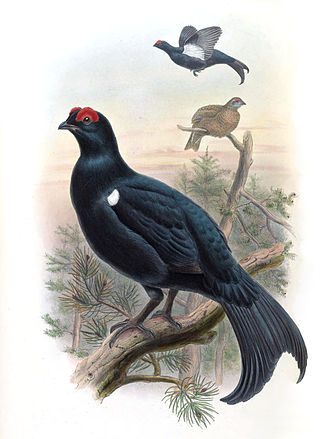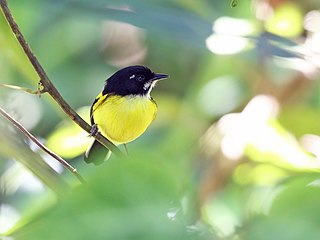
The Caucasian grouse or Caucasian black grouse is a large bird in the grouse family. It is closely related to the black grouse.

Grosbeak is a form taxon containing various species of seed-eating passerine birds with large beaks. Although they all belong to the superfamily Passeroidea, these birds are not part of a natural group but rather a polyphyletic assemblage of distantly related songbirds. Some are cardueline finches in the family Fringillidae, while others are cardinals in the family Cardinalidae; one is a member of the weaver family Ploceidae. The word "grosbeak", first applied in the late 1670s, is a partial translation of the French grosbec, where gros means "large" and bec means "beak".

The Azores bullfinch, also known as the São Miguel bullfinch, or locally in Portuguese as the priolo, is a threatened passerine bird in the true finch family. It is endemic to São Miguel Island, in the Azores archipelago of Macaronesia in the North Atlantic Ocean.

The Narina trogon is a largely green and red, medium-sized, bird of the family Trogonidae. It is native to forests and woodlands of the Afrotropics. Though it is the most widespread and catholic in habitat choice of the three Apaloderma species, their numbers are locally depleted due to deforestation. Some populations are sedentary while others undertake regular movements.

The Réunion cuckooshrike is a passerine bird in the cuckooshrike family. It is endemic to the island of Réunion, where it is restricted to two areas of mountain forest in the north of the island. Males are dark grey above and pale grey beneath, while females have dark brown upper parts and a streaked breast. The population has been declining and the range contracting, being currently about 16 square kilometres (6.2 sq mi), and the International Union for Conservation of Nature has rated the species as "critically endangered", with the possibility that the bird could be wiped out by a tropical storm. Conservation efforts are being made by attempting to control the cats and rats which prey on the chicks, and this seems to have resulted in the population stabilising.

Jameson's antpecker is a songbird species found in central Africa. Like all antpeckers, it is tentatively placed in the estrildid finch family (Estrildidae). It has traditionally been included as a subspecies of P. rubrifrons and the common name Jameson's antpecker was sometimes used for both taxa. But today, they are often considered distinct species.

The red-fronted antpecker is a species of songbird found in Western Africa. Like all antpeckers, it is tentatively placed in the estrildid finch family (Estrildidae). It often contains the eastern Jameson's antpecker as a subspecies.

The genus Rhynchostruthus is a small group of finches in the family Fringillinae. Commonly known as golden-winged grosbeaks, they are attractive, chunky, medium-sized, robust-billed songbirds restricted to the southern Arabian and northern Somalian regions.
The Escudo hummingbird is a hummingbird in the subfamily Trochilinae. It was long considered a doubtfully distinct species, but more recently it is generally treated as a subspecies of the rufous-tailed hummingbird, A. tzacatl.

The golden grosbeak, also known as golden-bellied grosbeak or southern yellow grosbeak, is a species of grosbeak in the family Cardinalidae. It is similar to, and has sometimes been considered conspecific with, the yellow grosbeak.

Benson's rock thrush is a songbird in the family Muscicapidae, formerly placed in the Turdidae together with the other chats. It is usually included in the forest rock thrush as a subspecies; e.g. BirdLife International revised its status to subspecies in 2008., however it was recognized as a distinct species at one time.

The Black-Backed Tody-Flycatcher is a species of bird in the family Tyrannidae, and one of twelve in the genus Poecilotriccus.

The Somali thrush, also known as the Somali blackbird, is a songbird species in the family Turdidae. It is endemic to Somalia.

The Himalayan cutia is a bird species in the family Leiothrichidae. Its scientific name ultimately means "the khutya from Nepal", as Cutia is derived from the Nepali name for these birds, and nipalensis is Latin for "from Nepal".
The Vietnamese cutia is a bird species in the family Leiothrichidae. It is found in Laos and Vietnam.

The Arabian golden-winged grosbeak or Arabian grosbeak is a finch found in Saudi Arabia, Oman and Yemen. It is included as a subspecies in R. socotranus by some authorities, but in recent times the three golden-winged grosbeak populations are usually considered distinct species.

The Socotra golden-winged grosbeak or Socotra grosbeak is a finch endemic to Socotra, an island in the Indian Ocean off the coast of Yemen. R. socotranus is by some authorities held to be the only species of the then-monotypic genus Rhynchostruthus, including all other golden-winged grosbeaks therein as subspecies. But in recent times the three populations are usually considered a distinct species, with R. socotranus being limited to the Socotra population, the Arabian golden-winged grosbeak becoming R. percivali, and the Somali golden-winged grosbeak R. louisae.

The greenfinches are small passerine birds in the genus Chloris in the subfamily Carduelinae within the Fringillidae. The species have a Eurasian distribution except for the European greenfinch, which also occurs in North Africa.

Gaanlibah or Ga'an Libah is mountain range, archaeological site, and national park located in the Maroodi Jeex region of Somaliland. Nearby are the Golis Mountains. Its upper slopes are the source of the seasonal Togdheer river that flows through the city of Burao into the Nugaal Valley.

The Asir magpie, also known as the Arabian magpie, is a highly endangered species of magpie endemic to Saudi Arabia. It is only found in the country's southwestern highlands, in the Asir Region. It occurs only in African juniper forest in well-vegetated wadis and valleys. It was formerly classified as a subspecies of the Eurasian magpie, and still is by many authorities. This species is highly threatened by habitat destruction, as its native forests are not regenerating. Tourism development and climate change are also posing a threat. Only 135 pairs are known to survive in the wild, and this number is declining.

















